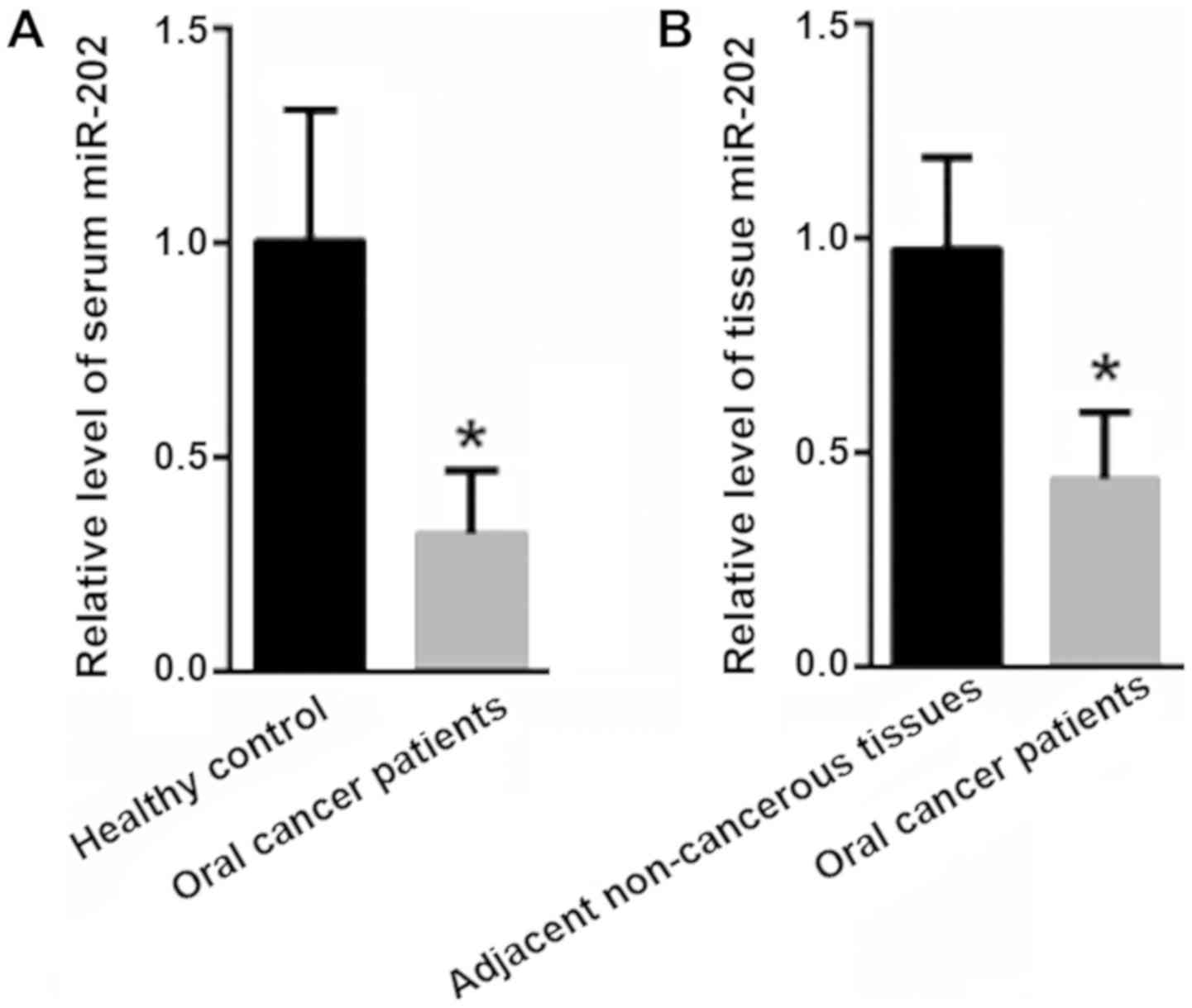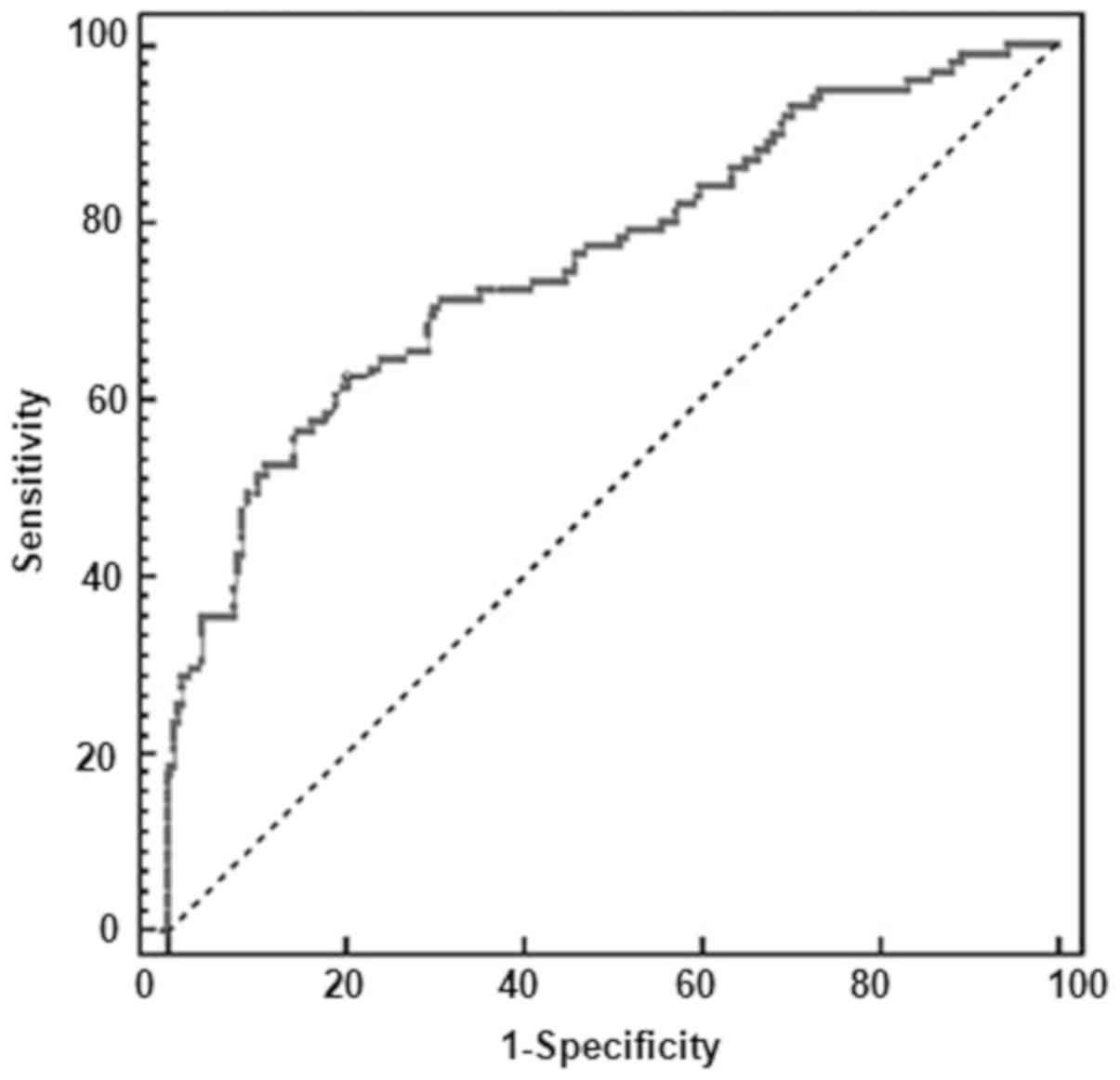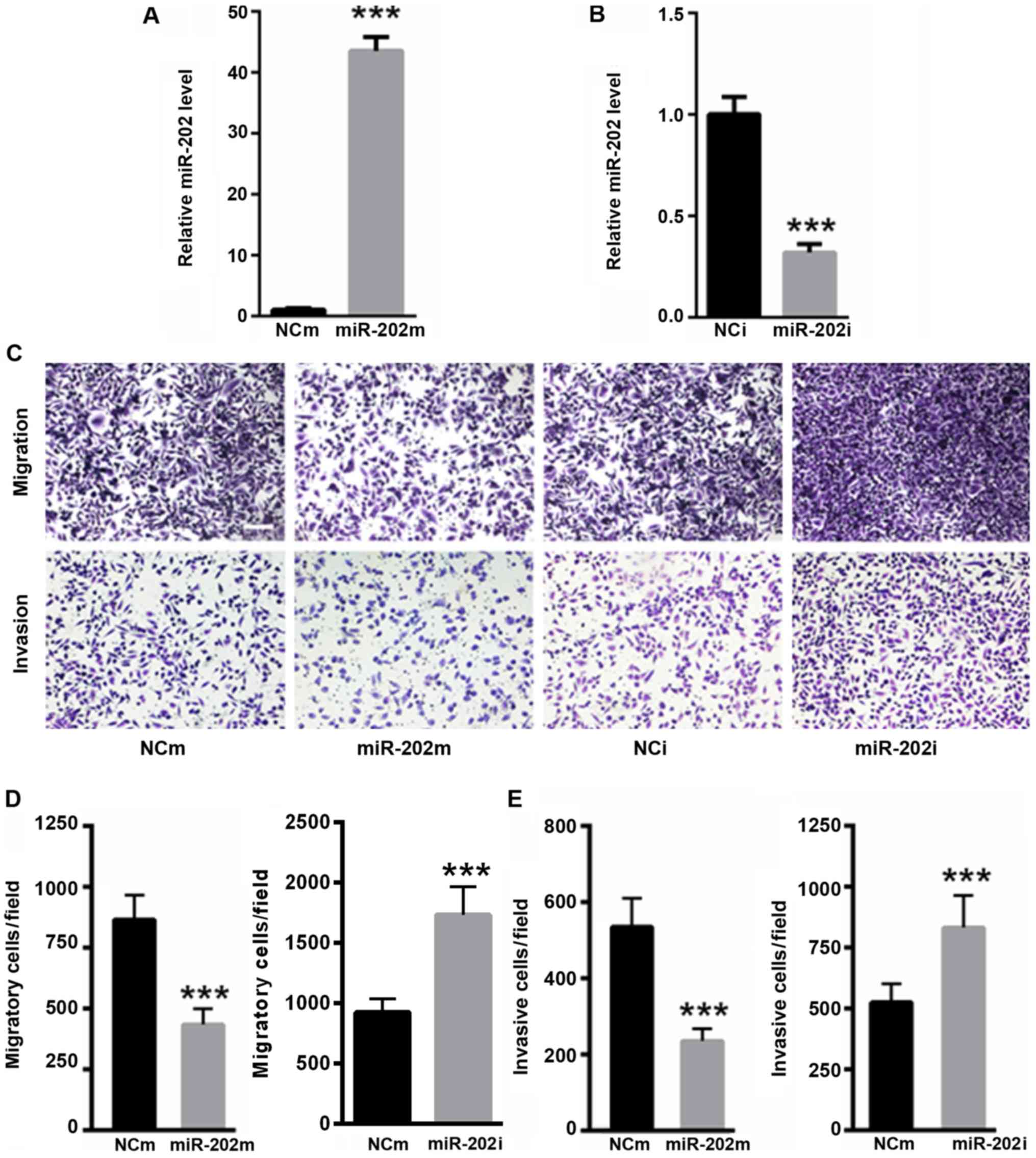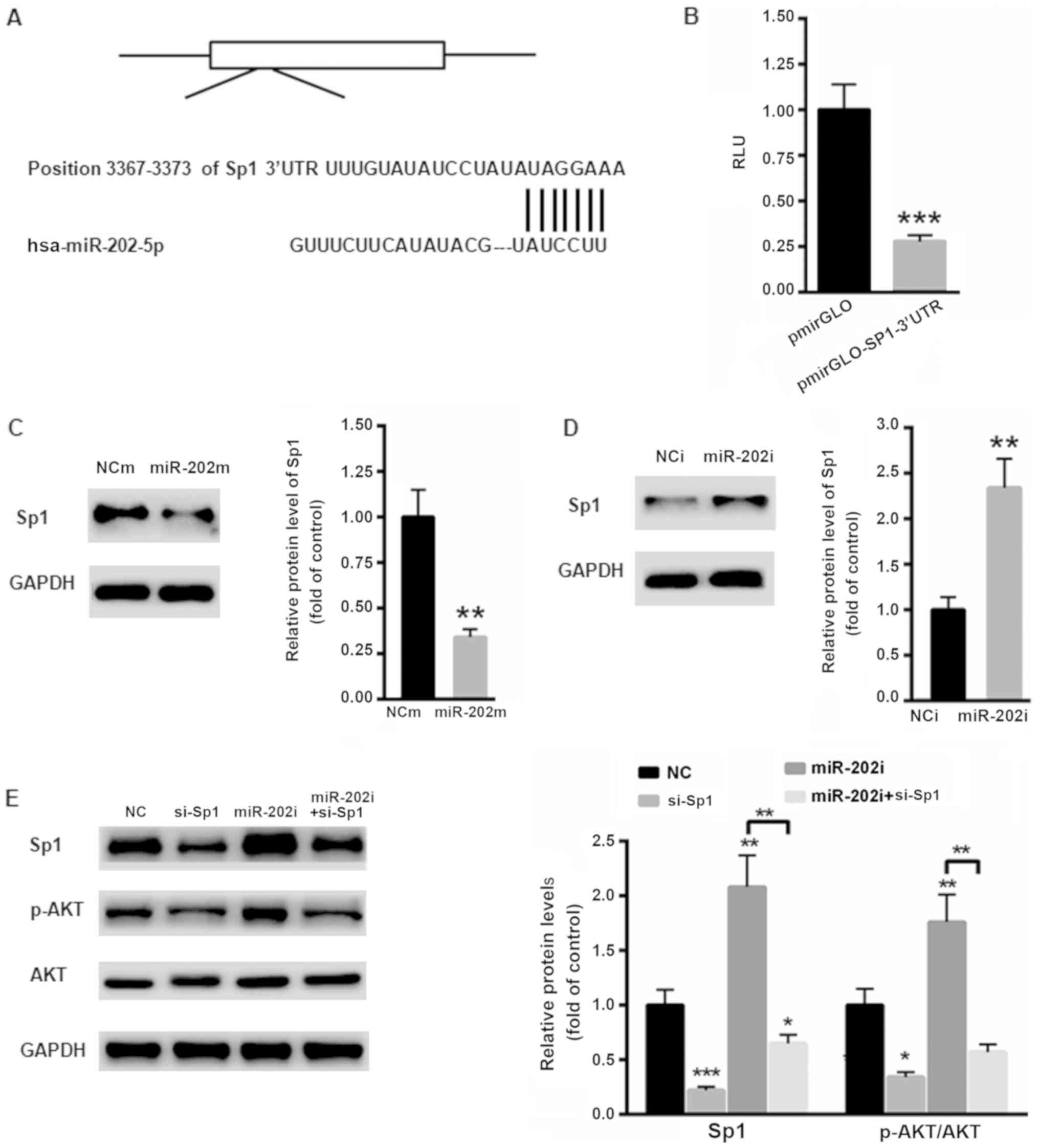|
1
|
Lin SS, Peng CY, Liao YW, Chou MY, Hsieh
PL and Yu CC: miR-1246 targets CCNG2 to enhance cancer stemness and
chemoresistance in oral carcinomas. Cancers (Basel). 10:E2722018.
View Article : Google Scholar : PubMed/NCBI
|
|
2
|
Min SK, Jung SY, Kang HK, Park SA, Lee JH,
Kim MJ and Min BM: Functional diversity of miR-146a-5p and TRAF6 in
normal and oral cancer cells. Int J Oncol. 51:1541–1552. 2017.
View Article : Google Scholar : PubMed/NCBI
|
|
3
|
Fang CY, Chen PY, Ho DC, Tsai LL, Hsieh
PL, Lu MY, Yu CC and Yu CH: miR-145 mediates the anti-cancer
stemness effect of photodynamic therapy with 5-aminolevulinic acid
(ALA) in oral cancer cells. J Formos Med Assoc. 117:738–742. 2018.
View Article : Google Scholar : PubMed/NCBI
|
|
4
|
Cheng CM, Shiah SG, Huang CC, Hsiao JR and
Chang JY: Up-regulation of miR-455-5p by the TGF-β-SMAD signalling
axis promotes the proliferation of oral squamous cancer cells by
targeting UBE2B. J Pathol. 240:38–49. 2016. View Article : Google Scholar : PubMed/NCBI
|
|
5
|
Christopher AF, Gupta M and Bansal P:
Micronome revealed miR-19a/b as key regulator of SOCS3 during
cancer related inflammation of oral squamous cell carcinoma. Gene.
594:30–40. 2016. View Article : Google Scholar : PubMed/NCBI
|
|
6
|
Dickman CT, Lawson J, Jabalee J, MacLellan
SA, LePard NE, Bennewith KL and Garnis C: Selective extracellular
vesicle exclusion of miR-142-3p by oral cancer cells promotes both
internal and extracellular malignant phenotypes. Oncotarget.
8:15252–15266. 2017. View Article : Google Scholar : PubMed/NCBI
|
|
7
|
Kuo YZ, Tai YH, Lo HI, Chen YL, Cheng HC,
Fang WY, Lin SH, Yang CL, Tsai ST and Wu LW: MiR-99a exerts
anti-metastasis through inhibiting myotubularin-related protein 3
expression in oral cancer. Oral Dis. 20:e65–e75. 2014. View Article : Google Scholar : PubMed/NCBI
|
|
8
|
Li TK, Yin K, Chen Z, Bao Y and Zhang SX:
MiR-214 regulates oral cancer KB cell apoptosis through targeting
RASSF5. Genet Mol Res. Mar 8–2017.(Epub ahead of print). doi:
10.4238/gmr16019327. View Article : Google Scholar
|
|
9
|
Li X, Fan Q, Li J, Song J and Gu Y:
MiR-124 down-regulation is critical for cancer associated
fibroblasts-enhanced tumor growth of oral carcinoma. Exp Cell Res.
351:100–108. 2017. View Article : Google Scholar : PubMed/NCBI
|
|
10
|
Ling Z, Liu D, Zhang G, Liang Q, Xiang P,
Xu Y, Han C and Tao T: miR-361-5p modulates metabolism and
autophagy via the Sp1-mediated regulation of PKM2 in prostate
cancer. Oncol Rep. 38:1621–1628. 2017. View Article : Google Scholar : PubMed/NCBI
|
|
11
|
Mak CS, Yung MM, Hui LM, Leung LL, Liang
R, Chen K, Liu SS, Qin Y, Leung TH, Lee KF, et al: MicroRNA-141
enhances anoikis resistance in metastatic progression of ovarian
cancer through targeting KLF12/Sp1/survivin axis. Mol Cancer.
16:112017. View Article : Google Scholar : PubMed/NCBI
|
|
12
|
Meng Q, Wang S, Tang W, Wu S, Gao N, Zhang
C, Cao X, Li X, Zhang Z, Aschner M, et al: XRCC1 mediated the
development of cervival cancer through a novel Sp1/Krox-20 swich.
Oncotarget. 8:86217–86226. 2017. View Article : Google Scholar : PubMed/NCBI
|
|
13
|
Muramoto K, Tange R, Ishii T, Miyauchi K
and Sato T: Downregulation of transcription factor Sp1 suppresses
malignant properties of A549 human lung cancer cell line with
decreased β4-galactosylation of highly branched N-glycans. Biol
Pharm Bull. 40:1282–1288. 2017. View Article : Google Scholar : PubMed/NCBI
|
|
14
|
Peng M, Hu Y, Song W, Duan S, Xu Q, Ding
Y, Geng J and Zhou J: MIER3 suppresses colorectal cancer
progression by down-regulating Sp1, inhibiting
epithelial-mesenchymal transition. Sci Rep. 7:110002017. View Article : Google Scholar : PubMed/NCBI
|
|
15
|
Yang CZ, Ma J, Zhu DW, Liu Y, Montgomery
B, Wang LZ, Li J, Zhang ZY, Zhang CP and Zhong LP: GDF15 is a
potential predictive biomarker for TPF induction chemotherapy and
promotes tumorigenesis and progression in oral squamous cell
carcinoma. Ann Oncol. 25:1215–1222. 2014. View Article : Google Scholar : PubMed/NCBI
|
|
16
|
Livak KJ and Schmittgen TD: Analysis of
relative gene expression data using real-time quantitative PCR and
the 2(-Delta Delta C(T)) method. Methods. 25:402–408. 2001.
View Article : Google Scholar : PubMed/NCBI
|
|
17
|
Liborio-Kimura TN, Jung HM and Chan EK:
miR-494 represses HOXA10 expression and inhibits cell proliferation
in oral cancer. Oral Oncol. 51:151–157. 2015. View Article : Google Scholar : PubMed/NCBI
|
|
18
|
Liu CM, Peng CY, Liao YW, Lu MY, Tsai ML,
Yeh JC, Yu CH and Yu CC: Sulforaphane targets cancer stemness and
tumor initiating properties in oral squamous cell carcinomas via
miR-200c induction. J Formos Med Assoc. 116:41–48. 2017. View Article : Google Scholar : PubMed/NCBI
|
|
19
|
Lopes CB, Magalhães LL, Teófilo CR, Alves
APNN, Montenegro RC, Negrini M and Ribeiro-Dos-Santos Â:
Differential expression of hsa-miR-221, hsa-miR-21, hsa-miR-135b
and hsa-miR-29c suggests a field effect in oral cancer. BMC Cancer.
18:7212018. View Article : Google Scholar : PubMed/NCBI
|
|
20
|
Su F, Geng J, Li X, Qiao C, Luo L, Feng J,
Dong X and Lv M: SP1 promotes tumor angiogenesis and invasion by
activating VEGF expression in an acquired trastuzumab-resistant
ovarian cancer model. Oncol Rep. 38:2677–2684. 2017. View Article : Google Scholar : PubMed/NCBI
|
|
21
|
Xiao Q, Zheng F, Wu J, Tang Q, Wang W and
Hann SS: Activation of ERK and mutual regulation of stat3 and SP1
contribute to inhibition of PDK1 expression by atractylenolide-1 in
human lung cancer cells. Cell Physiol Biochem. 43:2353–2366. 2017.
View Article : Google Scholar : PubMed/NCBI
|
|
22
|
Ye Y, Qian XY, Xiao MM, Shao YL, Guo LM,
Liao DP, Da J, Zhang LJ and Xu J: Decreased Sp1 expression mediates
downregulation of SHIP2 in gastric cancer cells. Int J Mol Sci.
18:E2202017. View Article : Google Scholar : PubMed/NCBI
|
|
23
|
Wang ZQ, Cai Q, Hu L, He CY, Li JF, Quan
ZW, Liu BY, Li C and Zhu ZG: Long noncoding RNA UCA1 induced by SP1
promotes cell proliferation via recruiting EZH2 and activating AKT
pathway in gastric cancer. Cell Death Dis. 8:e28392017. View Article : Google Scholar : PubMed/NCBI
|
|
24
|
Dauer P, Gupta VK, McGinn O, Nomura A,
Sharma NS, Arora N, Giri B, Dudeja V, Saluja AK and Banerjee S:
Inhibition of Sp1 prevents ER homeostasis and causes cell death by
lysosomal membrane permeabilization in pancreatic cancer. Sci Rep.
7:15642017. View Article : Google Scholar : PubMed/NCBI
|
|
25
|
Han D, Cho JH, Lee RH, Bang W, Park K, Kim
MS, Shim JH, Chae JI and Moon SY: Antitumorigenic effect of
atmospheric-pressure dielectric barrier discharge on human
colorectal cancer cells via regulation of Sp1 transcription factor.
Sci Rep. 7:430812017. View Article : Google Scholar : PubMed/NCBI
|
|
26
|
Huang H, Jin H, Zhao H, Wang J, Li X, Yan
H, Wang S, Guo X, Xue L, Li J, et al: RhoGDIβ promotes Sp1/MMP-2
expression and bladder cancer invasion through perturbing
miR-200c-targeted JNK2 protein translation. Mol Oncol.
11:1579–1594. 2017. View Article : Google Scholar : PubMed/NCBI
|


















